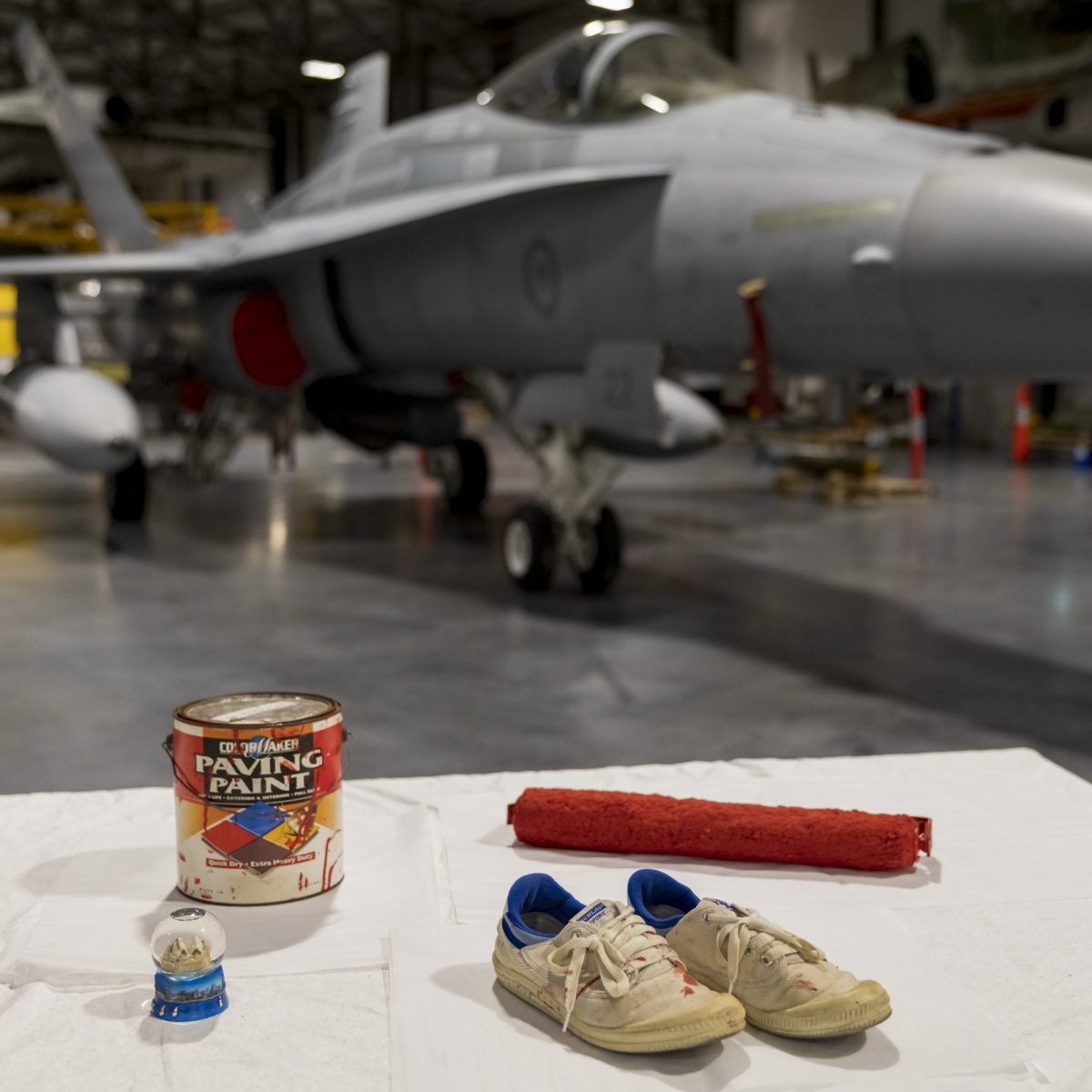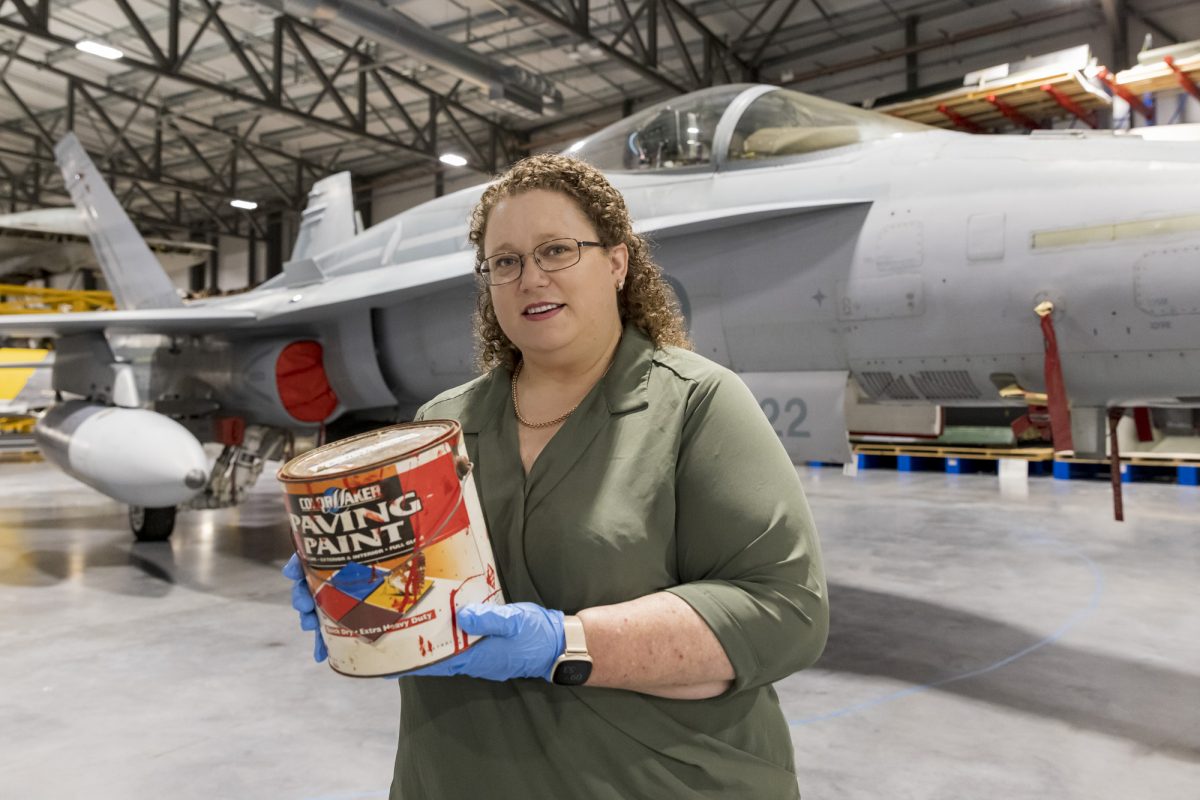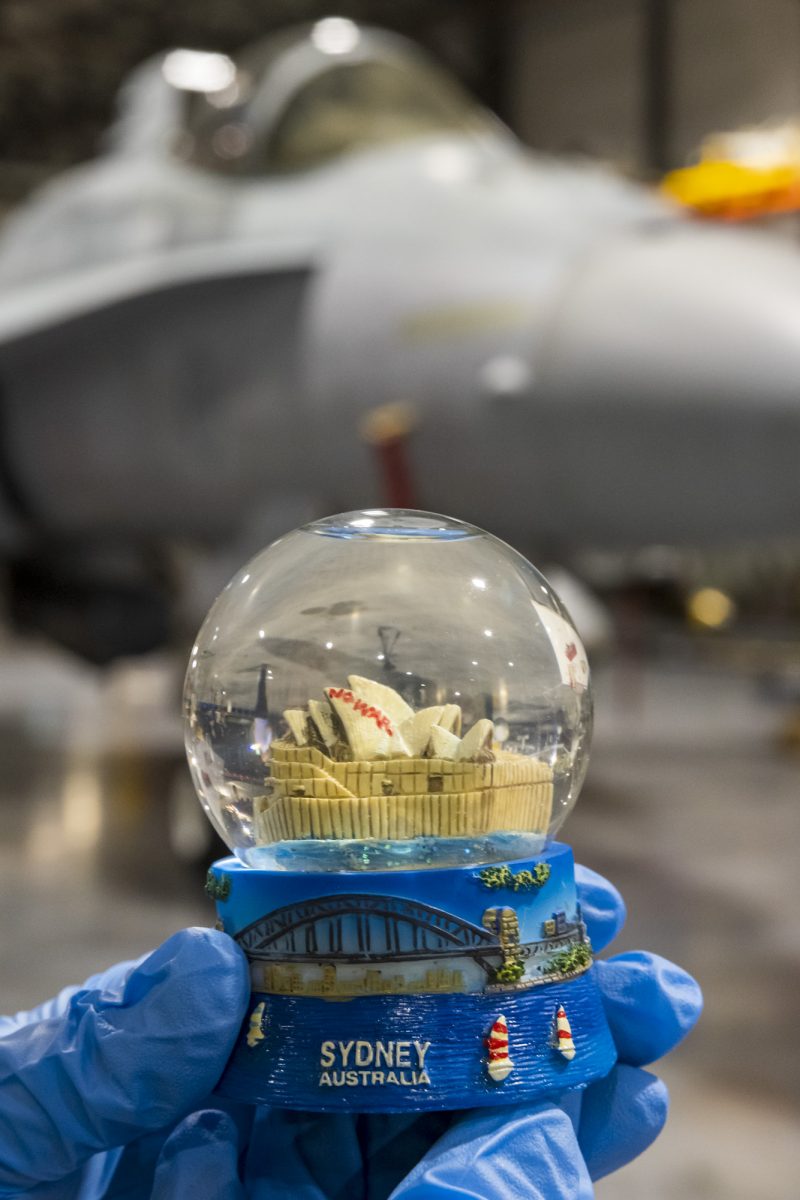
Items at the Australian War Memorial from the ‘NO WAR’ protest in Sydney in March 2003. Photo: David Whittaker.
The Australian War Memorial has revealed some of the items to be included in a new Iraq War gallery, in time for the 20th anniversary of the invasion.
The centrepiece will be an F/A-18 Hornet fighter jet, the first Australian aircraft to drop a bomb in conflict since Vietnam.
But there will also be objects of a more domestic nature – a can of red paint, a paint-crusted roller, a Sydney Opera House snow globe, and a pair of paint-splattered Dunlop sneakers.
Far from the contents of someone’s cupboard under the stairs, these are tied to one of the nation’s most dramatic protests.
On the morning of 18 March 2003, Australia was poised to join the UK and the US in a full-scale invasion of Iraq, with an objective to locate and destroy suspected weapons of mass destruction.
But closer to home, two men – Dave Burgess and Will Saunders – were scaling the largest of the tiled ‘sails’ on the Sydney Opera House.
Dave had bought a pair of white Dunlop Volley sneakers the day before after a brief reconnaissance of the site revealed he would need grippy shoes to help scale the landmark.
Once the pair reached the top, they pulled out a five-metre roller pole with the end soaked in red paint and began writing ‘NO WAR’ in giant block letters down the side of the roof.
In the same window of time, US President George Bush was addressing the American people on television, warning dictator Saddam Hussein he had 48 hours to leave Iraq or face military conflict.
The scene horrified those around Sydney Harbour and on the bridge, with reports of ferries honking and traffic stopping.

Dr Kerry Neale from the Australian War Memorial holding the paint can used in the ‘NO WAR’ protest in Sydney in March 2003. Photo: David Whittaker.
Burgess and Saunders were arrested soon after they climbed down. They were later convicted of malicious damage, sentenced to nine months’ periodic detention, and ordered to pay the Opera House’s $151,000 cleaning bill.
The men weren’t done graffitiing the Opera House yet, though. By buying snow globes from the souvenir shop and adding red ‘NO WAR’ lettering to the model inside, they found they could recoup some of the cost of the cleaning bill by on-selling them for $20.
These modified Opera House snow globes became a favourite way for anti-war sympathisers to support Burgess and Saunders.
Two days after the publicity stunt, on 20 March, a combined force of US, UK and Australian troops invaded Iraq in what was dubbed “the Second Gulf War”. Within three weeks, they had seized the capital of Baghdad and overthrown the brutal dictatorship of Saddam Hussein. Four Australian troops were killed, but no weapons of mass destruction were ever found.
But it wasn’t over yet. A ‘nation-building’ campaign followed. The last coalition troops left in 2011, ending the eight-year Iraq War.
Now, 20 years after the invasion, the Australian War Memorial’s $500 million redevelopment will include a new Iraq War gallery featuring military equipment and key objects from the ‘NO WAR’ protest.
Memorial director Matt Anderson says it’s about telling the whole story of the war, complete with those who didn’t want it to happen.
“Our new galleries will tell the story of Iraq in all of its complexity,” he says.
“Putting these items on display together at the Australian War Memorial is a powerful reminder that, in any healthy democracy, decisions to go to war and our community’s determined desire for peace are always interconnected.”

The protestors modified snow globes from the Opera House and sold them to help cover the cleaning bill. Photo: David Whittaker.
The crowd-puller is sure to be the F/A-18 Hornet. Lead curator Dr Kerry Neale says 14 of these from the 75 Squadron of the Royal Australian Air Force (RAAF) “played a significant role in the war in Iraq”.
At the height of the war, the Hornets were used to attack Iraqi ground forces with laser-guided bombs. Targets included tanks, trucks and artillery, as well as bunkers and storage areas for fuel and ammunition.
As Iraqi resistance crumbled, the Hornets also flew close air-support missions to assist Australian and other troops on the ground.
But closer to home, the actions of Burgess and Saunders are remembered by a sealed tin of red paint, paint-stained Dunlop shoes and one of their modified snow globes.
“The Memorial’s collection also consists of anti-war material in the collection, dating back from as early as the First World War, through to recent conflicts,” Dr Neale said.
“Many will remember one of the most iconic anti-war protests, when the Sydney Opera House was scaled by protestors and ‘NO WAR’ was painted on its famous sails.”
The Iraq War gallery is expected to open in late 2025.












